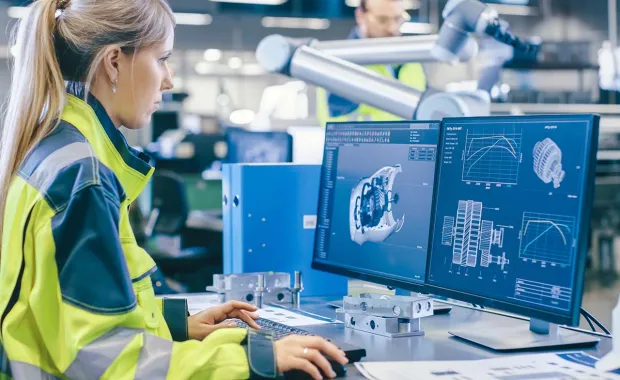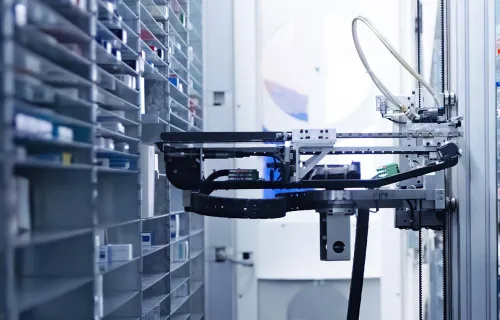Digital twin technology is not new. But this technology has increasingly gained traction over the last few years, from digital twins of whole cities and airplane engines to cars and bridges. Leading manufacturers today are looking to digital twins as critical enablers, not just to optimize operations, but to preempt change and respond proactively to market dynamics.
In this blog, I answer some key questions about digital twins and how using them to visualize and simulate decisions—before acting on them—helps manufacturers accelerate value creation.
What is a digital twin?
Simply put, a digital twin is a virtual replica of a physical system. It represents — as far as possible — the complete physical structure of the system, i.e., all its functions and components, as well as its processes and data. The digital twin reflects the "real life" of the object: its usage, maintenance, repair and actual operational environment. It can be constantly updated, and predictive models can evolve based on its life cycle using system data and behavior evolutions.
At an enterprise level in manufacturing, digital twin approaches can be applied to the following:
- Target system or product – this is the end system and services, for example, a wind turbine, that a manufacturer sells to a customer.
- Manufacturing system – this comprises the entire plant and production line that is used to build the wind turbine, i.e., the target system.
- Support system – this system covers the maintenance, repair and retrofit of the target system and can also support the main manufacturing system.
A digital twin instance (DTI) is associated with a given individual system or object. For instance, if there are 10 physical windmills, there will be 10 DTIs representing the life cycle of each one.
How do digital twins benefit manufacturers?
Digital twins can be utilized throughout the life cycle of a product, right from the early stages of product development, including the design and test phase, through to manufacturing, maintenance, repair, and retrofit, offering benefits at every stage. Some of the key benefits are as follows:
- Improve product design and accelerate innovation: Digital twins help create a positive loop-back from operations to the supply chain and R&D based on field data, production data or the manufacturing execution system to improve or evolve system design, processes and services.
- Drive continuous manufacturing optimization in real-time: Let's take the example of a wind turbine again. The design of a wind turbine must cater to customer, market and technical specification requirements. If these requirements change or evolve during the manufacturing process, the digital twin of the wind turbine can "talk" to the manufacturing system twin to make the necessary changes and reconfigure the production process to address the changes.
- Reduce time-to-market and cost: By using digital twins, manufacturers can design, test and develop prototypes much faster and reduce time to market by as much as 20-30%. This, in turn, helps to reduce costs.
- Enhance predictive capabilities: Besides predicting performance and behavior, digital twins make predicting and preventing equipment failures possible by monitoring real-time data, reducing the total cost of ownership (TCO) and asset downtime.
- Visualize and simulate decisions: Using its multiple predictive models based on the laws of physics or operational data, the digital twin can create multiple scenarios to be assessed for their outcomes and impacts to aid in decision-making. Here, integration of the system engineering framework and data sciences/AI methods is key.
Becoming data-driven to benefit from digital twins
Despite digital mockup technologies in R&D being around for several decades, manufacturers have yet to implement these technologies in an enterprise-wide way that delivers long-term business value. One of the biggest challenges is a lack of data uniformity, consistency and continuity. Here are five key considerations to begin your digital twin journey:
- Ensure your plans are aligned with the business objectives, for example, reducing time to market.
- Improve your industry value chain and challenge current practices through an advanced system engineering framework.
- Be clear on the models, objects and data ontology (the definitions, rules, usage and linkages across them).
- Ensure data continuity across the full life cycle of an object or system — from R&D to end-of-life.
- Move from a digital mockup to a digital twin through operational data valorization and associated dynamic predictive models (evolving along the life cycle).
Implementing digital twins is an incremental process. Huge amounts of data must be considered, so it's important that your business priorities drive your digital twin roadmap so you can achieve your vision, step by step, with continuity and consistency. Ensuring R&D data continuity across predictive models is a key first step. For example, If the system's TCO or its operational availability is mandatory, then the roadmap's first focus should be integrating maintenance repair overhaul (MRO)/integrated logistics support.
Using digital twins to accelerate innovation, experimentation and value creation
At CGI, we help clients across industries unlock the full potential of digital twins by focusing on business objectives, finding the right use cases, proving their value by quickly turning them into a solution, and scaling them. Some examples include:
- Improving operational reliability of defense fleet vehicles for a defense company through predictive maintenance and reconfiguration to optimize system usage and availability
- Building a 4D digital twin of a plant for a leading European mine to achieve higher maintenance efficiency and worker safety levels while reducing costs.
- Creating a digital twin for a future smart city in Finland using augmented reality and precision data
- Developing a reconstruction of the Earth (known as a Food System Digital Twin Precursor) as part of the European Space Agency's Digital Twin Earth program to advance understanding of global food systems
At CGI's global innovation center in Toulouse, France, we're helping clients realize the benefits of digital twin technology by developing use cases for manufacturing, such as using commercial-off-the-shelf (COTS) IT solutions to predict how events impact a manufacturing system. At the innovation center, we focus on co-building with manufacturing clients, the factory of the future, creating new manufacturing solutions and improving existing ones through innovation, and applying Industry 4.0 best practices to accelerate transformation.
Are you looking to progress your digital twin journey with practical, workable solutions? Contact me to visit our innovation center or discuss how we can help.





